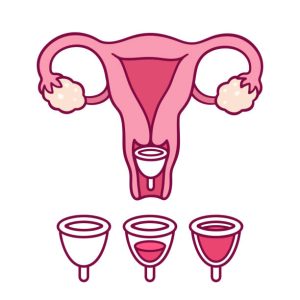 I didn’t know I was a crunchy mom until I had my first baby, and somehow breastfeeding and babywearing led me down a cloth diaper path, and before I knew it, that was just part of my identity. I had heard from my crunchy mom friends about menstrual cups but I was reluctant to give them a try. It seemed weird and messy, and the ones that were reliably available seemed expensive, at around $40.
I didn’t know I was a crunchy mom until I had my first baby, and somehow breastfeeding and babywearing led me down a cloth diaper path, and before I knew it, that was just part of my identity. I had heard from my crunchy mom friends about menstrual cups but I was reluctant to give them a try. It seemed weird and messy, and the ones that were reliably available seemed expensive, at around $40.
I had my three babies in four years – November 2009, October 2011, and March 2013. There weren’t a whole of menstrual cycles in between those pregnancies to really give anything other than the traditional pads and tampons a try. But after my last baby was born, I was ready to give menstrual cups a shot, and let me tell you, once I did, I was hooked. They were easier, lasted longer, needed less interference from me throughout the day, and were a lot more comfortable than I expected. I continued to use them until my hysterectomy.
So, what is a menstrual cup?
First of all, there are two main types.
The most common type of menstrual cup sits in your vagina, like a tampon. The cup creates a seal with the outer walls of your vagina and collects menstrual blood. These come in a variety of sizes, shapes, colors, and even firmness of the silicone used. High-quality cups are made of medical-grade silicone, which can last up to 10 years before needing replacement. These range in price from $10-$15 for some brands on Amazon, to the more common $40 or so, for the more widely known brands.


The other type of menstrual cup is a disc that sits flat across the opening to your cervix. There is both a disposable and a reusable option for these. Disposable ones may seem less “green” but you use far fewer of these than pads and tampons, so they are still a healthier environmental choice. The other advantage of a disc style cup is that you can continue to have vaginal intercourse, with little or no mess, while on your cycle.
How do you choose which cup is right for you?
Here are some things to consider when choosing a menstrual cup.
1. How high is your cervix?
If your cervix is on the higher side, the kind of cup that sits in your vagina should work well. You can then choose based on whether you’ve had children or not, and other considerations, which I’ll discuss later.
If you have a lower cervix – like you can easily reach it within a couple of knuckles of your fingers – you may opt for the disc version, or some of the traditional cups, like Femmecycle, offer a low cervix option.
(In order to determine how high your cervix is, you can use your fingers. Cervix height will vary at different points in your cycle.)
2. What’s your budget?
While $40 can seem like a high price to pay all at once, if you consider what you spend on pads and tampons over the course of a year, it’s really a bargain. Granted, you may need to try a couple of different sorts to find the right fit, however considering that’s $40 over the course of YEARS, there’s no comparison.
3. What Stem type do you get?
I am putting this one here as an important consideration because although it’s highly personal, it can really help narrow down the options. Easier to find options, like the Diva Cup, have a slender, almost string-like stem. This probably feels similar to a tampon string. Personally, I found this could be tricky to grab hold of, and I prefer a ring stem for easier gripping. Other individuals find a shorter stem more comfortable and easier to manage.

Troubleshooting
1. The Mess
The number one dilemma about cups is a mess. It feels like it will be messy. Well, periods are messy business. However, cups for most individuals will be just fine where they are for 10-12 hours. If you have very heavy cycles, you may find that time is shorter, more like 6-8 hours. Even so, you are dealing with period blood much less frequently than if you were using pads or tampons.
First, with a traditional cup, your fingers may or may not get messy. You dump the contents into the toilet. When at home, you can rinse before re-inserting the cup. When out in public, many individuals carry wet wipes to quickly clean before re-inserting. This way they can also wipe their fingers before going to wash their hands. Otherwise, washing the cup with soap and water every 10-12 hours is sufficient.
*A note on re-inserting – I know it feels like a cup should be totally sterile before reinsertion. You don’t want foreign matter on it, but as long as it is visibly clean, it’s okay. Most of the things that go into a vagina aren’t sterile but should be relatively clean.
With a disposable disc-type cup, you dump, wrap in toilet paper and dispose in a receptacle, much like a tampon.
2. Cleaning
In between cycles, you can sterilize your cup. I tended to soak mine in peroxide, but you can boil the cup if need be, or use sterilizing tabs. You can even use microwavable breast pump parts sterilizing bags.
3. Size
This is where the disc-style cups are at a disadvantage. They look huge! But trust me, they do really fit. To insert, you pinch them. So, instead of inserting a wide, flat disc, the cup becomes no wider than most tampons, just a bit longer. You insert it parallel to the floor and it “pops” open once in place, like an umbrella.
Likewise, the traditional cups you also pinch, but those are inserted more perpendicular to the floor. There are a ton of YouTube videos out there on various methods.
4. Leaks
The last sort of main hang-up is leaking. Whether you go with a disc or traditional cup, you really should not experience any leaks. Both cups create a seal that should prevent that. If you are experiencing leaks, it is either full, or the cup may not be the right fit for you. I had very heavy cycles (hence the hysterectomy – that level of heavy is NOT normal) and I often wore a panty liner or period underwear as backup, just in case.
All in all, cups are a really great option for a lot of people. Less mess, less expense overall, and they allow for a lot more freedom. And get this … cups, period underwear, and other period products are covered expenses under most healthcare saving/spending accounts.














